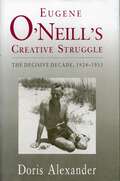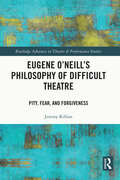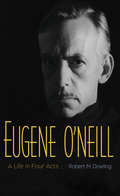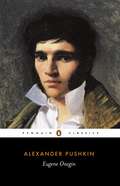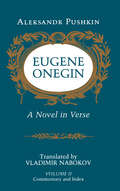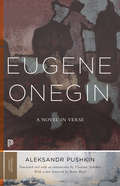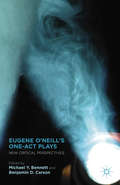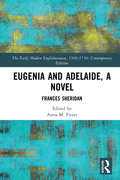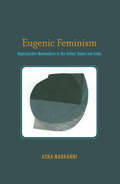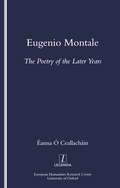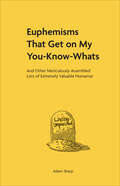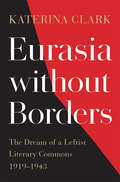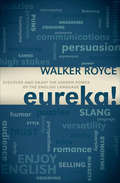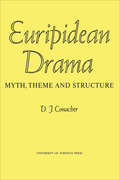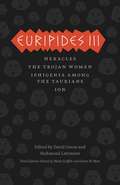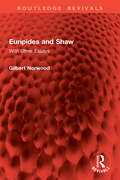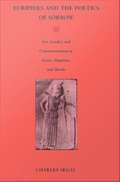- Table View
- List View
Eugene O'Neill's Creative Struggle: The Decisive Decade, 1924–1933 (G - Reference, Information and Interdisciplinary Subjects)
by Doris AlexanderIn Eugene O'Neill's Creative Struggle, Doris Alexander gives us a new kind of inside biography that begins where the others leave off. It follows O'Neill through the door into his writing room to give a blow-by-blow account of how he fought out in his plays his great life battles—love against hate, doubt against belief, life against death—to an ever-expanding understanding. It presents a new kind of criticism, showing how O'Neill's most intimate struggles worked their way to resolution through the drama of his plays. Alexander reveals that he was engineering his own consciousness through his plays and solving his life problems—while the tone, imagery, and richness of the plays all came out of the nexus of memories summoned up by the urgency of the problems he faced in them. By the way of O'Neill, this study moves toward a theory of the impulse that sets off a writer's creativity, and a theory of how that impulse acts to shape a work, not only in a dramatist like O'Neill but also in the case of writers in other mediums, and even of painters and composers. The study begins with Desire Under the Elms because that play's plot was consolidated by a dream that opened up the transfixing grief that precipitated the play for O'Neill, and it ends with Days Without End when he had resolved his major emotional-philosophical struggle and created within himself the voice of his final great plays. Since the analysis brings to bear on the plays all of his conscious decisions, ideas, theories, as well as the life-and-death struggles motivating them, documenting even the final creative changes made during rehearsals, this book provides a definitive account of the nine plays analyzed in detail (Desire Under the Elms, Marco Millions, The Great God Brown, Lazarus Laughed, Strange Interlude, Dynamo, Mourning Becomes Electra, Ah, Wilderness!, and Days Without End, with additional analysis of plays written before and after.
Eugene O'Neill's Philosophy of Difficult Theatre: Pity, Fear, and Forgiveness (Routledge Advances in Theatre & Performance Studies)
by Jeremy KillianThrough a close re-examination of Eugene O’Neill’s oeuvre, from minor plays to his Pulitzer-winning works, this study proposes that O’Neill’s vision of tragedy privileges a particular emotional response over a more “rational” one among his audience members. In addition to offering a new paradigm through which to interpret O’Neill’s work, this book argues that O’Neill’s theory of tragedy is a robust account of the value of difficult theatre as a whole, with more explanatory scope and power than its cognitivist counterparts. This paradigm reshapes our understanding of live theatrical tragedy’s impact and significance for our lives. The book enters the discussion of tragic value by way of the plays of Eugene O’Neill, and through this study, Killian makes the case that O’Neill has refused to allow Plato to define the terms of tragedy’s merit, as the cognitivists have. He argues that O’Neill’s theory of tragedy is non-cognitive and locates the value of a play in its ability to trigger certain emotional responses from the audience. This would be of great interest to students and scholars of performance studies, literature and philosophy.
Eugene O'Neill's The Iceman Cometh (Modern Critical Interpretations)
by Harold BloomLiterary interpretation in the form of critical essays on the Iceman Cometh.
Eugene O'Neill: A Life in Four Acts (American Critical Archives Ser.)
by Robert M. DowlingAn &“absorbing&” biography of the playwright and Nobel laureate that &“unflinchingly explores the darkness that dominated O&’Neill&’s life&” (Publishers Weekly). This extraordinary biography fully captures the intimacies of Eugene O&’Neill&’s tumultuous life and the profound impact of his work on American drama, innovatively highlighting how the stories he told for the stage interweave with his actual life stories as well as the culture and history of his time. Much is new in this extensively researched book: connections between O&’Neill&’s plays and his political and philosophical worldview; insights into his Irish American upbringing and lifelong torment over losing faith in God; his vital role in African American cultural history; unpublished photographs, including a unique offstage picture of him with his lover Louise Bryant; new evidence of O&’Neill&’s desire to become a novelist and what this reveals about his unique dramatic voice; and a startling revelation about the release of Long Day&’s Journey Into Night in defiance of his explicit instructions. This biography is also the first to discuss O&’Neill&’s lost play Exorcism (a single copy of which was only recently recovered), a dramatization of his own suicide attempt. Written with both a lively informality and a scholar&’s strict accuracy, Eugene O&’Neill: A Life in Four Acts is a biography worthy of America&’s foremost playwright. &“Fast-paced, highly readable . . . building to a devastating last act.&” —Irish Times
Eugene Onegin
by Alexander PushkinThis novel in verse, said to be the parent of all Russian novels, is a tragic story of innocence, love and friendship. Eugene Onegin, an aristocrat, much like Pushkin and his peers in his attitude and habits, is bored. He visits the countryside where the young and passionate Tatyana falls in love with him. In a touching letter she confesses her love but is cruelly rejected. Years later, it is Onegin's turn to be rejected by Tatyana.
Eugene Onegin: A Novel in Verse
by Alexander PushkinEugene Onegin is the master work of the poet whom Russians regard as the fountainhead of their literature. Set in 1820s Russia, Pushkin's verse novel follows the fates of three men and three women. Engaging, full of suspense, and varied in tone, it contains a large cast of characters and offers the reader many literary, philosophical, and autobiographical digressions, often in a highly satirical vein. Eugene Onegin was Pushkin's own favourite work, and this new translation by Stanley Mitchell conveys the literal sense and the poetic music of the original.
Eugene Onegin: A Novel in Verse: Commentary (Vol. 2)
by Aleksandr PushkinWhen Vladimir Nabokov first published his controversial translation of Pushkin’s Eugene Onegin in 1964, the great majority of the edition was taken up by Nabokov’s witty and detailed commentary. Presented here in its own volume, the commentary is a unique and exhaustive scholarly masterwork by one of the twentieth century’s greatest writers—a work that Nabokov biographer Brian Boyd calls “the most detailed commentary ever made on” Onegin and “indispensable to all serious students of Pushkin’s masterpiece.”In his commentary, Nabokov seeks to illuminate every possible nuance of this nineteenth-century classic. He explains obscurities, traces literary influences, relates Onegin to Pushkin’s other work, and in a characteristically entertaining manner dwells on a host of interesting details relevant to the poem and the Russia it depicts. Nabokov also provides translations of lines and stanzas deleted by the censor or by Pushkin himself, variants from Pushkin’s notebooks, fragments of a continuation called “Onegin’s Journey,” the unfinished and unpublished “Chapter Ten,” other continuations, and an index.A work of astonishing erudition and passion, Nabokov’s commentary is a landmark in the history of literary scholarship and in the understanding and appreciation of the greatest work of Russia’s national poet.
Eugene Onegin: A Novel in Verse: Text (Vol. 1) (Princeton Classics #36)
by Vladimir Nabokov Brian Boyd Aleksandr PushkinWhen Vladimir Nabokov's translation of Pushkin’s masterpiece Eugene Onegin was first published in 1964, it ignited a storm of controversy that famously resulted in the demise of Nabokov’s friendship with critic Edmund Wilson. While Wilson derided it as a disappointment in the New York Review of Books, other critics hailed the translation and accompanying commentary as Nabokov’s highest achievement. Nabokov himself strove to render a literal translation that captured "the exact contextual meaning of the original," arguing that, "only this is true translation." Nabokov’s Eugene Onegin remains the most famous and frequently cited English-language version of the most celebrated poem in Russian literature, a translation that reflects a lifelong admiration of Pushkin on the part of one of the twentieth century’s most brilliant writers. Now with a new foreword by Nabokov biographer Brian Boyd, this edition brings a classic work of enduring literary interest to a new generation of readers.
Eugene O’Neill’s One-Act Plays
by Michael Y. BennettGives long overdue attention to O'Neill's one-acts, this edited collection offers a variety of lenses through which to better understand both his one-act plays and entire oeuvre.
Eugenia and Adelaide, A Novel: Frances Sheridan (The Early Modern Englishwoman, 1500-1750: Contemporary Editions)
by Anna M FitzerFrances Sheridan’s Eugenia and Adelaide is an astonishing first novel of parental tyranny, infidelity, kidnap, blackmail, and violence played out over two volumes against the backdrop of continental Europe. The friendship of Eugenia and Adelaide endures in spite of their separation at the beginning of the novel and remains central to a complex yet coherently drawn web of intriguing tales situated in palatial apartments and remote moss-covered castles. Drawing upon the tragic and comic possibilities of disguise familiar to her from Shakespearean and Restoration drama, and influenced by the romantic entanglements of early prose fiction, Sheridan adopts a sometimes satirical approach to extraordinary events at the same time that she demonstrates a sincere and convincing commitment to the ingenious art of storytelling. Sheridan completed the novel in 1739 when she was just fifteen-years old and Eugenia and Adelaide would prove instrumental to the establishing of Sheridan’s literary reputation as one of the most successful novelists and dramatists of the mid-eighteenth century. This is the first modern edition of Eugenia and Adelaide to be published since the original posthumous publication of 1791 and presents a unique opportunity to explore Sheridan’s contribution to our current understandings of the history of women’s writing, and of reading tastes and practices in the long eighteenth century.
Eugenic Fantasies: Racial Ideology in the Literature and Popular Culture of the 1920's (Literary Criticism and Cultural Theory)
by Betsy Lee NiesEugenic Fantasies is an innovative work that combines interpretive strategies from the fields of psychoanalysis, anthropology, and literary studies to create a new model for theorizing race.
Eugenic Feminism: Reproductive Nationalism in the United States and India
by Asha NadkarniAsha Nadkarni contends that whenever feminists lay claim to citizenship based on women&’s biological ability to &“reproduce the nation&” they are participating in a eugenic project—sanctioning reproduction by some and prohibiting it by others. Employing a wide range of sources from the United States and India, Nadkarni shows how the exclusionary impulse of eugenics is embedded within the terms of nationalist feminism.Nadkarni reveals connections between U.S. and Indian nationalist feminisms from the late nineteenth century through the 1970s, demonstrating that both call for feminist citizenship centered on the reproductive body as the origin of the nation. She juxtaposes U.S. and Indian feminists (and antifeminists) in provocative and productive ways: Charlotte Perkins Gilman&’s utopian novels regard eugenic reproduction as a vital form of national production; Sarojini Naidu&’s political speeches and poetry posit liberated Indian women as active agents of a nationalist and feminist modernity predating that of the West; and Katherine Mayo&’s 1927 Mother India warns white U.S. women that Indian reproduction is a &“world menace.&” In addition, Nadkarni traces the refashioning of the icon Mother India, first in Mehboob Khan&’s 1957 film Mother India and Kamala Markandaya&’s 1954 novel Nectar in a Sieve, and later in Indira Gandhi&’s self-fashioning as Mother India during the Emergency from 1975 to 1977.By uncovering an understudied history of feminist interactivity between the United States and India, Eugenic Feminism brings new depth both to our understanding of the complicated relationship between the two nations and to contemporary feminism.
Eugenics and Other Evils
by G. K. ChestertonMr. Chesterton's long essay on eugenics and other evils was written in 1922, just a few years after the close of the 'Great War.' This war was not yet known as World War I, and it could not then be imagined that a greater calamity could be possible. Chesterton ends with the acidic observation that if his readers don't believe how toxic materialistic philosophies are, "neither would they believe though one rose from the dead." Prophetic; Chesterton would die in 1936, a few short years before the horrors of World War II, carried out once again by the hands of those who rejected Christianity and embraced a secular humanism grounded in atheistic evolutionary theory. This deserves our careful consideration, and no author demands it with such wit, humor, and intellect.
Eugenics, Literature, and Culture in Post-war Britain (Routledge Interdisciplinary Perspectives on Literature)
by Clare HansonThis book explores eugenics in its wider social context and in literary representations in post-war Britain. Drawing on a wide range of sources in medicine, social and educational policy, genetics, popular science, science fiction, and literary texts, Hanson tracks the dynamic interactions between eugenic ideas across diverse cultural fields, demonstrating the strength of the eugenic imagination. Challenging assumptions that eugenics was fatally compromised by its association with Nazi atrocities, or that it petered out in the context of changed social attitudes in an egalitarian post-war society, the book demonstrates that eugenic thought not only persisted after 1945, but became more prominent. Throughout, eugenics is defined as a cultural movement, rather than more narrowly as a science, and the study is focused on its border-crossing capacity as a ‘style of thought.’ By tracing the expression of eugenic ideas across disciplinary boundaries and in both high and low culture, this book demonstrates the powerful and pervasive influence of eugenics in the post-war years. Authors visited include Raymond Williams, John Braine, Agatha Christie, Muriel Spark, Anthony Burgess, Doris Lessing, and J.G. Ballard.
Eugenio Montale: The Poetry of the Later Years
by Eanna O Ceallachain"Eugenio Montale (1896-1981) is best known for the intense lyrical vision of his first three collections of poetry, written between the 1920s and early 1950s. With the publication of ""Satura"" in 1971, the profile of his work changes irrevocably as a new disillusioned voice emerged, commenting ironically on post-war Italian society and debunking his own previous poetic myths. O'Ceallachin, while placing this body of work firmly in its historical and ideological context, explores the poetic texts in detail, approaching the work from a variety of interpretative and thematic angles, and constructing a comprehensive reading of Montale's later work."
Euphemania: Our Love Affair with Euphemisms
by Ralph KeyesHow did die become kick the bucket, underwear become unmentionables, and having an affair become hiking the Appalachian trail? Originally used to avoid blasphemy, honor taboos, and make nice, euphemisms have become embedded in the fabric of our language. EUPHEMANIA traces the origins of euphemisms from a tool of the church to a form of gentility to today's instrument of commercial, political, and postmodern doublespeak. As much social commentary as a book for word lovers, EUPHEMANIA is a lively and thought-provoking look at the power of words and our power over them.
Euphemisms That Get on My You-Know-Whats: And Other Meticulously Assembled Lists of Extremely Valuable Nonsense
by Adam SharpEver wondered what the Mandarin word for platypus translates to? Probably not, but it&’s &“duck mouth beast.&” And there&’s more where that came from, thanks to Adam Sharp&’s Euphemisms That Get on My You-Know-Whats, a collection of fascinating, hilarious, and brilliantly odd lists.This book covers just about everything you never knew you didn&’t know, from the noises that animals make around the world to titles of movies that sound dirty but aren&’t—and much more. Whether you revel in trivia, desire more creative ways to curse your foes, or simply enjoy the structure of a good list, you&’ll love the weird genius of Euphemisms That Get on My You-Know-Whats.
Eurasia without Borders: The Dream of a Leftist Literary Commons, 1919–1943
by Katerina ClarkA long-awaited corrective to the controversial idea of world literature, from a major voice in the field. Katerina Clark charts interwar efforts by Soviet, European, and Asian leftist writers to create a Eurasian commons: a single cultural space that would overcome national, cultural, and linguistic differences in the name of an anticapitalist, anti-imperialist, and later antifascist aesthetic. At the heart of this story stands the literary arm of the Communist International, or Comintern, anchored in Moscow but reaching Baku, Beijing, London, and parts in between. Its mission attracted diverse networks of writers who hailed from Turkey, Iran, India, and China, as well as the Soviet Union and Europe. Between 1919 and 1943, they sought to establish a new world literature to rival the capitalist republic of Western letters. Eurasia without Borders revises standard accounts of global twentieth-century literary movements. The Eurocentric discourse of world literature focuses on transatlantic interactions, largely omitting the international left and its Asian members. Meanwhile, postcolonial studies have overlooked the socialist-aligned world in favor of the clash between Western European imperialism and subaltern resistance. Clark provides the missing pieces, illuminating a distinctive literature that sought to fuse European and vernacular Asian traditions in the name of a post-imperialist culture. Socialist literary internationalism was not without serious problems, and at times it succumbed to an orientalist aesthetic that rivaled any coming from Europe. Its history is marked by both promise and tragedy. With clear-eyed honesty, Clark traces the limits, compromises, and achievements of an ambitious cultural collaboration whose resonances in later movements can no longer be ignored.
Eureka! 21 Stories of Momentous Discoveries and Inventions (Critical Reading Series)
by Henry Billings Melissa Billings21 Stories of Momentous Discoveries and Inventions--with Exercises for Developing Reading Comprehension and Critical Thinking Skills
Eureka!: Discover and Enjoy the Hidden Power of the English Language
by Walker RoyceLearn the ins and outs of effective written and oral communication through a collection of trivia, puzzles, lists, anecdotes, and practical lessons. Eureka! illuminates the oddities, the amusement, and the communication power to be found in the English language. Instead of highlighting all the mechanics and hairball rules of English, Walker Royce leads you through an educational and entertaining workout of your English knowledge and skills. Provocative insights into high-stakes forms of communication—speaking, coaching, selling, interviewing, and even romance—are mixed with English language trivia, humorous anecdotes, and unique puzzles. His inspiring perspective will transform you into a better listener, writer, speaker, and teammate, and it will stimulate some deeper self-observation—a catalyst for improving your own communications proficiency.
Euripidean Drama: Myth, Theme and Structure
by Desmond ConacherIt is a commonly held view among historians of Greek literature that with the advent of Euripides the tragic structure, even the tragic outlook of Greek drama suffered a breakdown from which it never recovered. While there is much truth in this opinion, it has tended to put too much emphasis on "Euripides the destroyer" rather than "Euripides the creator." In this study the author's main purpose is to redress the balance and to discuss the structure and techniques of Euripidean drama in relation to its new and richly varied themes.The consistent dramatic form evolved by Aeschylus and Sophocles had grown out of their conception of tragedy as the resultant of the tension between the individual will and the universal order suggested in myth. For Euripides, who never fully accepted myth as the real basis of tragedy, alternate ways of using the traditional material became necessary, and the playwright continually changed his dramatic structure to suit the particular tragic idea he was seeking to express. Viewed in this way, Euripides' dramatic technique may be seen in positive as well as negative terms—as something other than the breakdown of structural technique and mythological insight under the overwhelming force of his ideas. Professor Conacher offers here a new view of Euripides as the first Greek dramatist properly to understand the world of myth, and so, in a sense, to stand a bit outside it. He shows how Euripides, far from being an impatient or incompetent craftsman, used traditional mth as a basis for inventing new forms in which to cast his perceptions of the sources of human tragedy. All the extant Euripidean drama is examined in this book; the result is an intelligent guide to the plays for all students of dramatic literature, as well as a convincing defence of Euripides the creator.
Euripides III: The Complete Greek Tragedies, Third Edition
by David Grene Richmond Lattimore"Euripides III" contains the plays Heracles, translated by William Arrowsmith; The Trojan Women, translated by Richmond Lattimore; Iphigenia among the Taurians, translated by Anne Carson; and Ion, translated by Ronald Frederick Willetts. Sixty years ago, the University of Chicago Press undertook a momentous project: a new translation of the Greek tragedies that would be the ultimate resource for teachers, students, and readers. They succeeded. Under the expert management of eminent classicists David Grene and Richmond Lattimore, those translations combined accuracy, poetic immediacy, and clarity of presentation to render the surviving masterpieces of Aeschylus, Sophocles, and Euripides in an English so lively and compelling that they remain the standard translations. Today, Chicago is taking pains to ensure that our Greek tragedies remain the leading English-language versions throughout the twenty-first century. In this highly anticipated third edition, Mark Griffith and Glenn W. Most have carefully updated the translations to bring them even closer to the ancient Greek while retaining the vibrancy for which our English versions are famous. This edition also includes brand-new translations of Euripides "Medea," "The Children of Heracles," "Andromache," and "Iphigenia among the Taurians," fragments of lost plays by Aeschylus, and the surviving portion of Sophocles s satyr-drama "The Trackers. " New introductions for each play offer essential information about its first production, plot, and reception in antiquity and beyond. In addition, each volume includes an introduction to the life and work of its tragedian, as well as notes addressing textual uncertainties and a glossary of names and places mentioned in the plays. In addition to the new content, the volumes have been reorganized both within and between volumes to reflect the most up-to-date scholarship on the order in which the plays were originally written. The result is a set of handsome paperbacks destined to introduce new generations of readers to these foundational works of Western drama, art, and life. "
Euripides and Shaw: With Other Essays (Routledge Revivals)
by Gilbert NorwoodEuripides and Shaw (1921) looks at Bernard Shaw and English Drama as great stylistic changes were sweeping the English stage. Shaw and Euripides are compared, and the important plays of the time are examined before moving on to an analysis of the very facets of drama itself.
Euripides and the Instruction of the Athenians
by Justina GregoryPolitical by its very nature, Greek tragedy reflects on how life should be lived in thepolis, and especially thepolisthat was democratic Athens. Instructional as well, drama frequently concerns itself with the audience's moral education. Euripides and the Instruction of the Atheniansdraws on these political and didactic functions of tragedy for a close analysis of five plays:Alcestis, Hippolytus, Hecuba, Heracles, andTrojan Women. Clearly written and persuasively argued, this volume addresses itself to all who are interested in Greek tragedy. Nonspecialists and scholars alike will deepen their understanding of this complex writer and the tumultuous period in which he lived. ". . . a lucid presentation of the positive side of Euripidean tragedy, and a thoughtful reminder of the political implications of Greek tragedy. " --American Journal of Philology ". . . the principal defect of [this] otherwise excellent study is that it is too short. " --Erich Segal,Classical Review ". . . a most stimulating book throughout . . . . " --Greece and Rome Justina Gregory is Professor of Classics, Smith College, where she is head of the department. She has been the recipient of Fulbright and Woodrow Wilson fellowships.
Euripides and the Poetics of Sorrow: Art, Gender, and Commemoration in Alcestis, Hippolytus, and Hecuba
by Charles SegalWhere is the pleasure in tragedy? This question, how suffering and sorrow become the stuff of aesthetic delight, is at the center of Charles Segal's new book, which collects and expands his recent explorations of Euripides' art. Alcestis, Hippolytus, and Hecuba, the three early plays interpreted here, are linked by common themes of violence, death, lamentation and mourning, and by their implicit definitions of male and female roles. Segal shows how these plays draw on ancient traditions of poetic and ritual commemoration, particularly epic song, and at the same time refashion these traditions into new forms. In place of the epic muse of martial glory, Euripides, Segal argues, evokes a muse of sorrows who transforms the suffering of individuals into a "common grief for all the citizens," a community of shared feeling in the theater. Like his predecessors in tragedy, Euripides believes death, more than any other event, exposes the deepest truth of human nature. Segal examines the revealing final moments in Alcestis, Hippolytus, and Hecuba, and discusses the playwright's use of these deaths--especially those of women--to question traditional values and the familiar definitions of male heroism. Focusing on gender, the affective dimension of tragedy, and ritual mourning and commemoration, Segal develops and extends his earlier work on Greek drama. The result deepens our understanding of Euripides' art and of tragedy itself.
